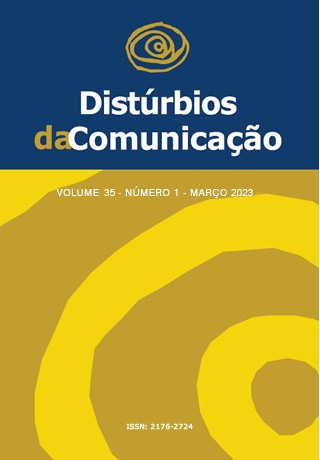Percepciones de los logopedas sobre el modelo profesional (role model)
DOI:
https://doi.org/10.23925/2176-2724.2023v35i1e57702Palabras clave:
Universidade, Profesionalismo, Mentores, Docentes, FonoaudiologíaResumen
Objetivo: Identificar la percepción de los egresados de un curso de logopedia sobre modelos profesionales importantes (role model) durante la práctica profesional en la graduación. Método: Estudio transversal aprobado por el Comité de Ética e Investigación (Dictamen nº 4.188.795). Los voluntarios incluyeron 106 graduados de Logopedia de una institución pública del interior del estado de São Paulo que recibieron un instrumento (Google Forms) compuesto por declaraciones relacionadas con el modelo profesional en una escala de respuesta psicométrica del tipo Likert (1-5) . Los datos fueron tabulados y analizados utilizando estadísticas no paramétricas. Resultados: Los participantes identificaron a los profesores y preceptores como sus principales referentes profesionales. Los atributos referidos a habilidades clínicas obtuvieron un mayor grado de importancia, mientras que las habilidades investigativas se consideraron menos representativas de un modelo profesional. Conclusión: Los atributos relacionados con un buen modelo profesional encontrados en este estudio pueden contribuir para el desarrollo profesional de profesores y preceptores y para la creación de un ambiente de aprendizaje favorable para el estudiante.
Descargas
Citas
Tang FWK, Chan AWK. Learning experience of nursing students in a clinical partnership model: Já exploratory qualitative analysis. Nurse EducToday. 2019; 75 (1): 6-12. DOI: 10.1016/j.nedt.2019.01.003
Passi V. Doctor role modelling in medical education. Med Teach. 2013; 35 (9): 1422-1436. DOI: 10.3109/0142159X.2013.806982
Wright SM. Attributes of rea fs attending physician role models. N Engl J Med. 1998; 339 (27): 1986-1998. DOI: 10.1056/NEJM199812313392706
Passi V. Developing medical professionalism in future doctors: a systematic review. Int J Med Educ. 2010; 11 (1): 19-29. DOI: 10.5116/ijme.4bda.ca2a
Plenário do Conselho Nacional de Saúde (CNS) - Resolução/CNS Nº 610. Diretriz Curricular Nacional em Fonoaudiologia. 2018.
Gibbs SS, Kulig JC. “We definitely are role models”: Exploring how clinical instructors influence nursing students’ rea f towards older adults. Nurse Educ Pract. 2017; 26 (1): 74-81. DOI: 10.1016/j.nepr.2017.07.006
Mandrá PP, Kuroishi RCS, Gomes NAS, Alpes MF. Percepção de estudantes de Fonoaudiologia sobre a Supervisão Clínica. Já Dist Com. 2019; 31 (2): 246-254. DOI: 10.23925/2176-2724.2019v31i2p246-254
Oosthuizen H, Klop D, Visser M. Navigating professional roles in early literacy intervention: exploring the experiences of speech language therapy students, teachers and clinical tutors. SAJCE. 2016; 5 (3): 1-10. DOI: 10.4102/sajce.v5i3.339
Lima RJ. Construction of professional identity in nursing students: qualitative research from the historical-cultural perspective. Já Lat Am Enfermangem. 2020; 28 (1): 1-10. DOI: 10.1590/1518-8345.3820.3284.
Silva LC, Troncon LEA, Panúncio-Pinto MP. Perceptions of occupational therapy students and clinical tutors on the rea fs of a good role model. Scand. J. Occup. Ther. 2019; 26 (4): 283-293. DOI: 10.1080/11038128.2018.1508495
Elzubeir MA, Rizk DE. Identifying characteristics that students, interns and rea fs look for in their role models. Med Educ. 2001; 35 (3): 272-277. DOI: 10.1046/j.1365-2923.2001.00870.x
Brasil BC, Gomes E, Teixeira MRF. Fontoura. O ensino de Fonoaudiologia no Brasil: Retrato dos cursos de Graduação. Trab, Educ e Saúde. 2019; 17 (3): 1-19. DOI: 0.1590/1981-7746-sol00214.
Moraes KO. Analysis of the expansion of supply and rea fs Speech-Language Pathology/Audiology courses in Brazil between 1994 and 2014. Já CEFAC. 2018; 20 (4): 484-492. DOI: doi.org/10.1590/1982-0216201820413617.
Burgess A, Goulston K, Oates K. Role modelling of clinical tutors: a focus group study among medical students. BMC Med Educ. 2016; 14 (5): 1-15. DOI 10.1186/s12909-015-0303-8
Tagawa M. Effects of undergraduate medical students’ individual rea fs on perceptions of encounters with positive and negative role models. BMC Med Educ. 2016; 23 (1): 160-164. DOI: DOI 10.1186/s12909-016-0686-1.
Jack K, Hamshire C, Chambers A. The influence of role models in undergraduate nurse education. J Clin Nurs. 2017; 26 (2): 4707-4715. DOI: 10.1111/jocn.13822
Wright SM, Carrese JÁ. Excellence in role modeling: insight and perspectives from the pros. CMAJ. 2002; 167 (6): 638-643.
Cruess SR, Cruess RL, Steinert Y. Role modelling – making the rea f a powerful teaching strategy. The BMJ. 2008; 336 (1): 76-86. DOI: 10.1136/bmj.39503.757847.BE
Silva LC, Colares MFA, Panúncio-Pinto MP, Troncon, LEA. The teacher as a role model to its students: perspectives from the health rea. Scient Med, 2019;29(4):1-5. DOI: 10.15448/1980-6108.2019.4.35862
Descargas
Publicado
Número
Sección
Licencia
Derechos de autor 2023 Matheus Francoy Alpes, Patricia Pupin Mandrá, Juliana Oliveira Silva

Esta obra está bajo una licencia internacional Creative Commons Atribución 4.0.









